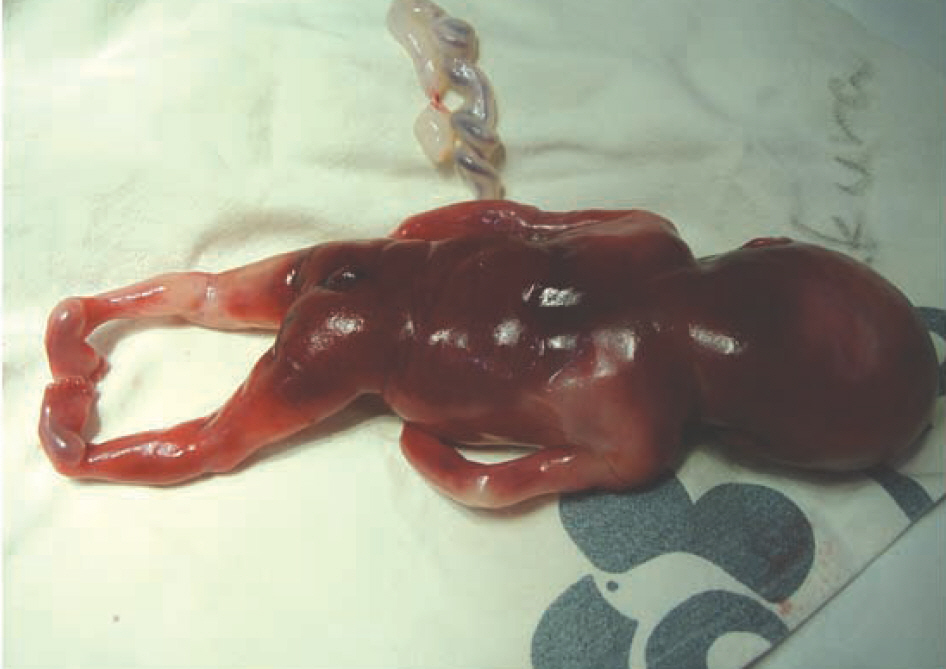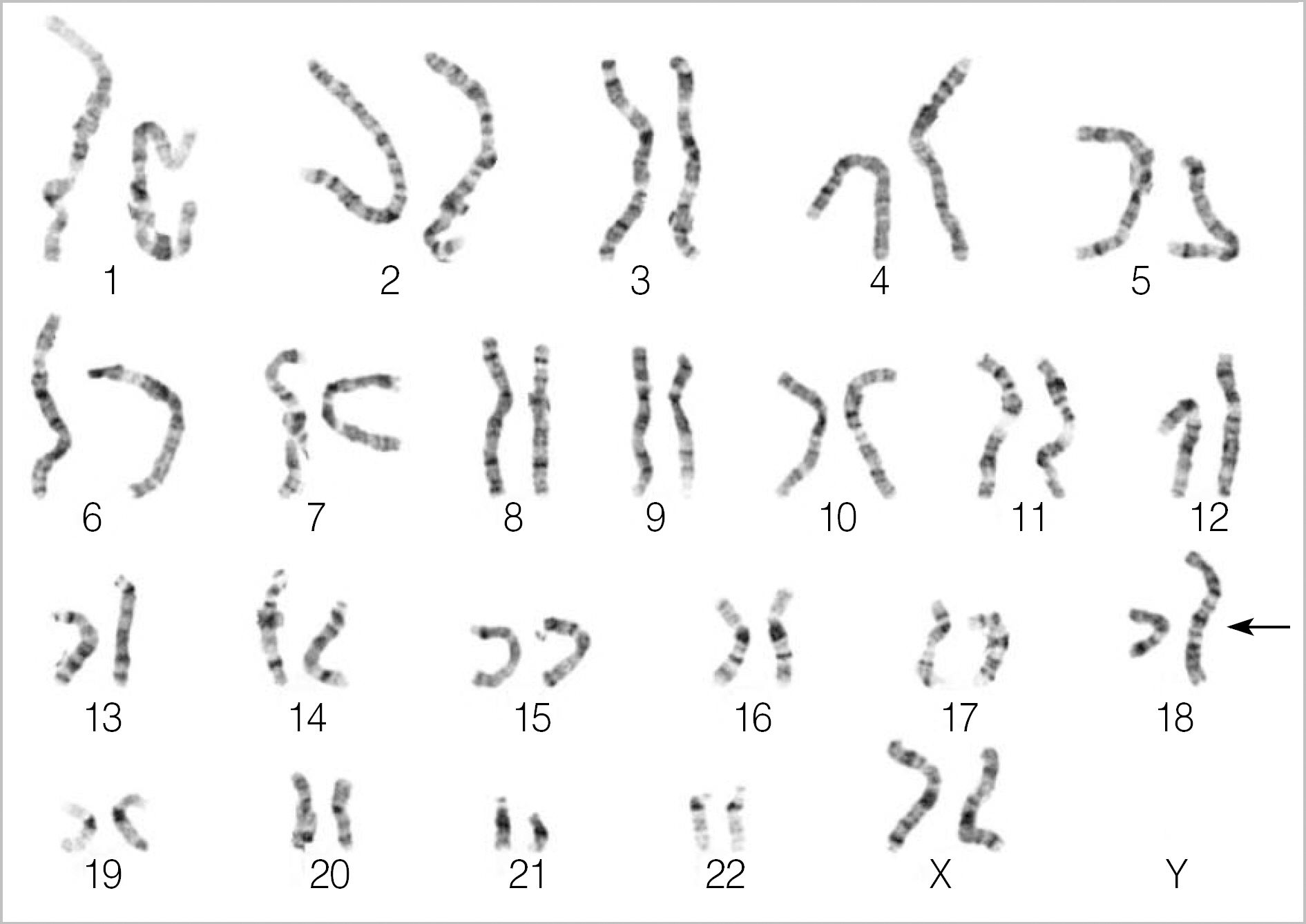Korean J Lab Med.
2010 Aug;30(4):440-443. 10.3343/kjlm.2010.30.4.440.
A Case of Pseudoisodicentric Chromosome 18q Detected at Prenatal Diagnosis
- Affiliations
-
- 1Department of Laboratory Medicine, College of Medicine, Kyung Hee University, Seoul, Korea.
- 2Department of Laboratory Medicine, Yonsei University College of Medicine, Seoul, Korea.
- 3Department of Obstetrics and Gynecology, College of Medicine, Kyung Hee University, Seoul, Korea. eui2536@hotmail.com
- KMID: 1781652
- DOI: http://doi.org/10.3343/kjlm.2010.30.4.440
Abstract
- Although trisomy 18 (Edwards' syndrome) or the terminal deletion syndromes of 18p and 18q have been occasionally detected, pseudoisodicentric chromosome 18 is a very rare constitutional chromosomal abnormality. We describe a case of pseudoisodicentric chromosome 18q without mosaicism, which was confirmed from fetal cells in the amniotic fluid used for prenatal diagnosis of multiple congenital anomalies. A 23-yr-old pregnant woman was suspected of having a fetal anomaly at 18(+3) weeks gestation. In sonography, the fetus showed multiple anomalies: bilateral overt ventriculomegaly in the brain, ventricular septal defect and valve anomaly in the heart, bilateral club foot, polydactyly, meningocele, and a single umbilical artery. The pregnancy was terminated and a conventional G-banded chromosome study was performed using amniotic fluid. Twenty metaphase cells among the cultured amniocytes showed a 46,XX,psu idic(18)(q22). Consequently, the fetus had partial trisomy (18pter-->q22) and partial monosomy (18q22-->qter). Both parents were confirmed to have a normal karyotype.
Keyword
MeSH Terms
Figure
Reference
-
1.Lin CC., Li YC., Liu PP., Hsieh LJ., Cheng YM., Teng RH, et al. Identification and characterization of a new type of asymmetrical dicentric chromosome derived from a single maternal chromosome 18. Cytogenet Genome Res. 2007. 119:291–6.
Article2.Morrissette JJ., Medne L., Bentley T., Owens NL., Geiger E., Pipan M, et al. A patient with mosaic partial trisomy 18 resulting from dicentric chromosome breakage. Am J Med Genet A. 2005. 137:208–12.
Article3.Ward BE., Bradley CM., Cooper JB., Robinson A. Homodicentric chromosomes: a distinctive type of dicentric chromosome. J Med Genet. 1981. 18:54–8.
Article4.Lemyre E., der Kaloustian VM., Duncan AM. Stable non-Robertsonian dicentric chromosomes: four new cases and a review. J Med Genet. 2001. 38:76–9.
Article5.Higgins AW., Gustashaw KM., Willard HF. Engineered human dicentric chromosomes show centromere plasticity. Chromosome Res. 2005. 13:745–62.
Article6.Therman E., Trunca C., Kuhn EM., Sarto GE. Dicentric chromosomes and the inactivation of the centromere. Hum Genet. 1986. 72:191–5.
Article7.Madan K., Vlasveld L., Barth PG. Ring-18 and isopseudodicentric-18 in the same child: a hypothesis to account for common origin. Ann Genet. 1981. 24:12–6.8.Meins M., Böhm D., Grossmann A., Herting E., Fleckenstein B., Fauth C, et al. First non-mosaic case of isopseudodicentric chromosome 18 (psu idic(18)(pter → q22.1::q22.1 → pter) is associated with multiple congenital anomalies reminiscent of trisomy 18 and 18q- syndrome. Am J Med Genet A. 2004. 127A:58–64.9.Brandt CA., Djernes B., Str⊘mkjaer H., Petersen MB., Pedersen S., Hindkjaer J, et al. Pseudodicentric chromosome 18 diagnosed by chromosome painting and primed in situ labelling (PRINS). J Med Genet. 1994. 31:99–102.
Article10.Matsuoka R., Matsuyama S., Yamamoto Y., Kuroki Y., Matsui I. Trisomy 18q. A case report and review of karyotype-phenotype correlations. Hum Genet. 1981. 57:78–82.11.Oudesluijs GG., Hulzebos CV., Sikkema-Raddatz B., Van Essen AJ. Mosaic isodicentric chromosome 18q: sixth report and review. Genet Couns. 2006. 17:395–400.12.Feenstra I., Vissers LE., Orsel M., van Kessel AG., Brunner HG., Veltman JA, et al. Genotype-phenotype mapping of chromosome 18q deletions by high-resolution array CGH: an update of the phenotypic map. Am J Med Genet A. 2007. 143A:1858–67.
Article13.Wallerstein R., Yu MT., Neu RL., Benn P., Lee Bowen C., Crandall B, et al. Common trisomy mosaicism diagnosed in amniocytes involving chromosomes 13, 18, 20 and 21: karyotype-phenotype correlations. Prenat Diagn. 2000. 20:103–22.
Article
- Full Text Links
- Actions
-
Cited
- CITED
-
- Close
- Share
- Similar articles
-
- A Case of 18q-Deletion Syndrome with Hydronephrosis and Anhydrosis
- Prenatal detection of Xq deletion by abnormal noninvasive prenatal screening, subsequently diagnosed by amniocentesis: A case report
- Prenatal detection of de novo inversion of chromosome 9 with duplicated heterochromatic region and postnatal follow-up
- Prenatal Diagnosis of Tetralogy of Fallot Associated with Chromosome 22q11 Deletion
- Prenatal diagnosis of 5p deletion syndrome: A case series report




